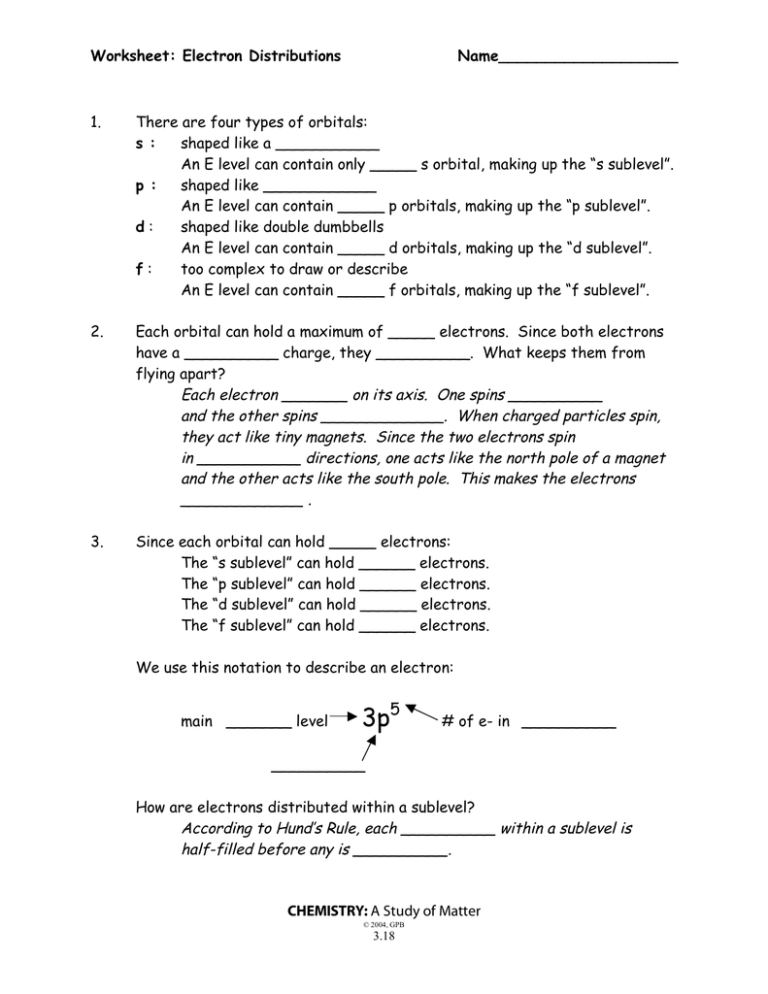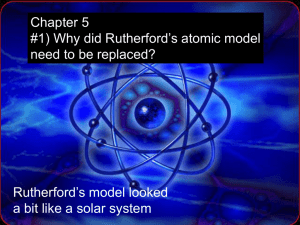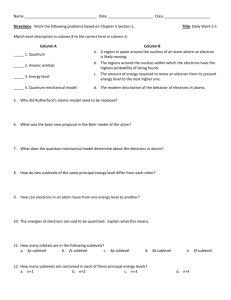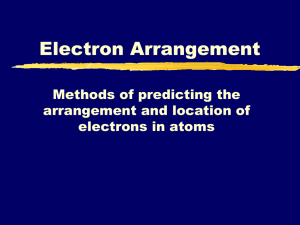Worksheet: Electron Distributions Name___________________ s :
advertisement

Worksheet: Electron Distributions Name___________________ 1. There are four types of orbitals: s : shaped like a ___________ An E level can contain only _____ s orbital, making up the “s sublevel”. p : shaped like ____________ An E level can contain _____ p orbitals, making up the “p sublevel”. d: shaped like double dumbbells An E level can contain _____ d orbitals, making up the “d sublevel”. f: too complex to draw or describe An E level can contain _____ f orbitals, making up the “f sublevel”. 2. Each orbital can hold a maximum of _____ electrons. Since both electrons have a __________ charge, they __________. What keeps them from flying apart? Each electron _______ on its axis. One spins __________ and the other spins _____________. When charged particles spin, they act like tiny magnets. Since the two electrons spin in ___________ directions, one acts like the north pole of a magnet and the other acts like the south pole. This makes the electrons _____________ . 3. Since each orbital can hold _____ electrons: The “s sublevel” can hold ______ electrons. The “p sublevel” can hold ______ electrons. The “d sublevel” can hold ______ electrons. The “f sublevel” can hold ______ electrons. We use this notation to describe an electron: main _______ level 3p5 # of e- in __________ __________ How are electrons distributed within a sublevel? According to Hund’s Rule, each __________ within a sublevel is half-filled before any is __________. CHEMISTRY: A Study of Matter © 2004, GPB 3.18 We draw orbital diagrams to show the distribution of electrons in a sublevel. Circles are used to represent the individual ________. __________ are used to represent electrons in the orbital. The first electron in an orbital is represented by a ! and the second by a ! . A set of four ______________ numbers is assigned to each __________ to describe its energy and location within the atom. The quantum numbers use the symbols _______, _______, _______, and _______. _______ is the principle quantum number and represents the ________ level of the electron. _______ represents the sublevel of the electron, which depends on the type of _____________. Pauli’s Exclusion Principle states that within an atom, no two electrons can have the same set of _____________ _____________. If two electrons have the same n, l, and m numbers, they are in the same _______ level, the same ___________, and the same _____________. They must then have ____________spins! So, the s quantum numbers must be different. Practice: Write electron distributions and do the orbital notation for the following: 1. P: 2. Ca: Only do the electron distributions for the following: 1. Co: 2. Eu: 3. Tc: CHEMISTRY: A Study of Matter © 2004, GPB 3.19





